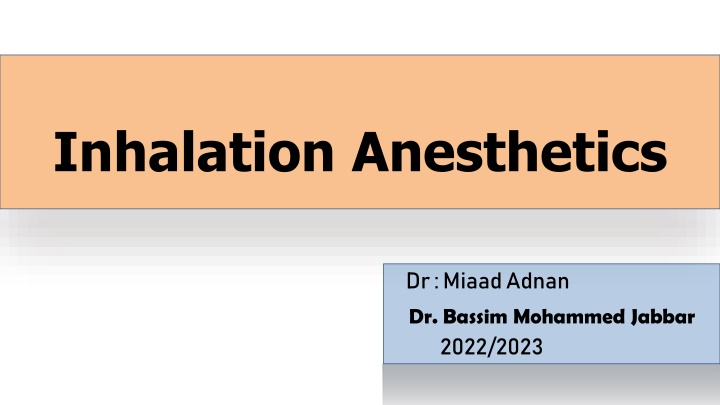
Inhalation Anesthetics Overview: Principles, Agents, and Pharmacokinetics
Discover the fundamental principles of inhalation anesthetics including the triad of general anesthesia, ideal characteristics, pharmacokinetics, and factors affecting gas concentration. Explore the various inhalational anesthetic agents, their delivery methods, and essential considerations for effective administration. Improve your understanding of anesthesia with insights from Dr. Miaad Adnan and Dr. Bassim Mohammed Jabbar. Dive into the world of inhalation anesthetics for a comprehensive overview in 2022/2023.
Download Presentation

Please find below an Image/Link to download the presentation.
The content on the website is provided AS IS for your information and personal use only. It may not be sold, licensed, or shared on other websites without obtaining consent from the author. If you encounter any issues during the download, it is possible that the publisher has removed the file from their server.
You are allowed to download the files provided on this website for personal or commercial use, subject to the condition that they are used lawfully. All files are the property of their respective owners.
The content on the website is provided AS IS for your information and personal use only. It may not be sold, licensed, or shared on other websites without obtaining consent from the author.
E N D
Presentation Transcript
Inhalation Anesthetics Dr: MiaadAdnan Dr. Bassim Mohammed Jabbar 2022/2023
1 Basic Principles of Anesthesia : Anesthesia defined as the abolition of sensation Analgesia defined as the abolition of pain Triad of General Anesthesia Need for unconsciousness Need for analgesia Need for muscle relaxation
2 Inhalational Anesthetic Agents : Inhalational anesthesia refers to the delivery of gases or vapors from the respiratory system to produce anesthesia Pharmacokinetics--uptake, distribution, and elimination from the body Pharmacodyamics-- MAC value
3 Ideal Characteristics : 1. Be pleasant to inhale, permitting a smooth induction and emergence. 2. Be potent to allow the concomitant administration of high oxygen. 3. Rapid induction and emergence (low solubility). 4. Be easy to administer .
4 Ideal Characteristics : 5. Be easily and cheaply prepared in pure form. 6. Be stable in storage and with soda-lime, not flammable, not metabolized. 7. Act at specific CNS sites to cause unconsciousness. 8. No CVS or respiratory effects, non-toxic to organ systems. 9. Provide postop pain relief .
5 Pharmacokinetics of Inhalation Anesthetics I) FACTORS AFFECTING INSPIRED GAS CONCENTRATION (FI) II) FACTORS AFFECTING ALVEOLAR GAS CONCENTRATION (FA) C ) Concentration A ) Uptake B ) Ventilation
6 I) FACTORS AFFECTING INSPIRED GAS CONCENTRATION (FI) 1. Fresh Gas Flow Rate ( Increase ) 2. Volume of Breathing system ( Decrease ) 3. Gas Absorption by anaesthetic machine or breathing circuit ( Decrease ) So Inspired Gas Concentration near to fresh gas Concentration
7 II) FACTORS AFFECTING ALVEOLAR GAS CONCENTRATION (FA) : A ) Uptake : Uptake ? alveolar gas Concentration If Decrease or no uptake (alveolar gas Concentration reach to the inspired gas Concentration) If uptake slow raise in alveolar Concentration slow induction
9 II) FACTORS AFFECTING ALVEOLAR GAS CONCENTRATION (FA) : A ) Uptake : Therefore, the greater the uptake of anesthetic agent, the greater the difference between inspired and alveolar concentrations, and the slower the rate of induction.
10 II) FACTORS AFFECTING ALVEOLAR GAS CONCENTRATION (FA) : A ) Uptake / FACTOR Affecting uptake : 1) 2) 3) gas and venous blood Solubility in the blood Alveolar blood flow Difference in partial pressure between alveolar
11 II) FACTORS AFFECTING ALVEOLAR GAS CONCENTRATION (FA) : A ) Uptake / FACTOR Affecting uptake : 1 - Solubility ( partition coefficient ) Less Soluble -- less uptake -- more raise in alveolar Concentration -- rapid induction of anaesthetic E.g : ( Nitrous Oxide ) more Soluble -- more uptake -- less raise in alveolar concentration -- slow induction E.g ( Halothane )
13 Inhalation Anesthetics / Table 1 :
13 II) FACTORS AFFECTING ALVEOLAR GAS CONCENTRATION (FA) : A ) Uptake / FACTOR Affecting uptake : 2 ) Alveolar blood flew ( Cardiac output COP ) : COP uptake --- raise in alveolar partial pressure --- rapid induction of anaesthesia (This effect for soluble more than in soluble --- so in COP (shock PT ) so need to in MAC
14 II) FACTORS AFFECTING ALVEOLAR GAS CONCENTRATION (FA) : A ) Uptake / FACTOR Affecting uptake : 3 ) Difference in partial pressure between alveolar gas and venous blood If not pass to organs E.g. ( Brain ) (venous and alveolar partial pressure ) equal --- No uptake
14 II) FACTORS AFFECTING ALVEOLAR GAS CONCENTRATION (FA) : A ) Uptake / FACTOR Affecting uptake : Systemic Uptake Transfer of anesthetic agent from blood to tissues --- systemic uptake 1 Tissue /blood partition coefficient (solubility ) 2 Tissue blood flow 3 Deference in partial pressure between Arterial blood and tissue
15 Inhalation Anesthetics / Table 2 :
16 II) FACTORS AFFECTING ALVEOLAR GAS CONCENTRATION (FA) : B ) Ventilation Ventilation --- alveolar anaesthetic concentration --- rapid induction in (soluble) anaesthetic agent No effect for (insoluble) agent C ) Concentration Anaesthetic gas concentration --- rapid induction of anaesthesia
18 What is MAC ? : Minimum Alveolar Concentration : Minimal alveolar concentration of inhalational agent that prevent movement in 50% of the patients in response to surgical stimulation (skin incision) Equivalent to ED50 For the same agent, varies with age, temperature and other drugs on board
19 A -Respiratory Effects of Inhalation Anesthetics Abolish the hypoxic response at less than half MAC concentrations Fantastic bronchodilators by direct action on smooth muscle
20 B - Cardiovascular Effects of Inhalation Anesthetics : All cause cardiac depression Cardiac depression causes an increased rate of gas alveolar concentration rise Isoflurane and desflurane cause increased heart rate which may mask cardiac depression Systemic vascular resistance Isoflurane and desflurane decrease (great for starting IVs) Halothane and nitrous oxide do not change Steal phenomena
22 C - CNS Effects of Inhalation Anesthetics : Hypnotic, not analgesic Cause unconsciousness Spinal cord depression (lack of reflexes) D - Renal Effects of Inhalation Anesthetics : All decrease arterial pressure RBF (Renal Blood Flow) and GFR (Glomerular Filtration Rate) will be maintained until threshold of autoregulation, Enflurane nephrotoxic
24 1 - Nitrous Oxide : Characterized by inert nature with minimal metabolism Colorless, odorless, tasteless, and does not Flammable Only anesthetic agent that is inorganic Week Anesthetic good analgesic agent Not metabolized N2O
25 1 - Nitrous Oxide : low potency MAC value is 105% Weak anesthetic, powerful analgesic Needs other agents for surgical anesthesia Low blood solubility (quick recovery)
27 1 - Nitrous Oxide : Minimal effects on heart rate and blood pressure May cause myocardial depression in sick patients Little effect on respiration
27 1 - Nitrous Oxide / Side Effects: Hypoxic mixtures can be used Large volumes of gases can be used Beginning of case: second gas effect End of case: diffusion hypoxia Diffusion into closed spaces Inhibits vitamin B-12 metabolism
28 2 Halothan : Halogen substituted ethane Volatile liquid easily vaporized, stable, and nonflammable Most potent inhalational anesthetic MAC of 0.75% Very soluble in blood and adipose
29 2 Halothane Systemic Effects : Inhibits sympathetic response to painful stimuli Inhibits sympathetic driven baroreflex response (hypovolemia) Sensitizes myocardium to effects of exogenous catecholamines-- ventricular arrhythmias
30 2 Halothane Systemic Effects : Decreases respiratory drive-- central response to CO2 and peripheral to O2 Depresses myocardium-- lowers BP Mild peripheral vasodilation
31 2 Halothane Systemic Effects : Halothane Hepatitis -- 1/10,000 cases fever, jaundice, hepatic necrosis, death metabolic breakdown products are hapten-protein conjugates immunologically mediated assault exposure dependent
32 2 Halothane Systemic Effects : Malignant Hyperthermia-- 1/60,000 with succinylcholine to 1/260,000 without Classic-- rapid rise in body temperature, muscle rigidity, tachycardia, rhabdomyolysis, acidosis, hyperkalemia, DIC Family history
33 2 Halothane Systemic Effects : Malignant Hyperthermia high association with muscle disorders autosomal dominant inheritance diagnosis--previous symptoms, increase CO2, rise in CPK levels, myoglobinuria, muscle biopsy physiology--hyper metabolic state by inhibition of calcium reuptake in sarcoplasmic reticulum
34 2 Halothane Systemic Effects : Malignant Hyperthermia (Treatment) : Early detection . Stop agents . Change breathing circuit . Change anesthetic machine if possible . Hyperventilate (Increase respiratory rate ) . Sodium Bicarbonate . Antidot IV dantrolene (2.5 mg/kg) . Ice packs/cooling blankets. Lasix / Mannitol / Fluids. ICU monitoring
36 3 Enflurane /Systemic Effects Systemic Effects: Stable, nonflammable liquid MAC 1.68% Potent inotropic and chronotropic depressant and decreases systemic vascular resistance-- lowers blood pressure and Stable, nonflammable liquid MAC 1.68% conduction dramatically Inhibits sympathetic baroreflex response Sensitizes myocardium to effects of exogenous catecholamines-- arrhythmias
37 3 Enflurane /Systemic Effects Systemic Effects: Respiratory drive is greatly depressed-- central and peripheral responses Increases dead space Produces hypercarbia (icrease CO2 ) in Spontaneously breathing patient
38 3 Enflurane /Systemic Effects Systemic Effects: Metabolism one-tenth that of halothane-- does not release quantity of hepatotoxic metabolites Metabolism releases fluoride ion-- renal toxicity Epileptiform EEG patterns
39 4 Isoflurane : Nonflammable,pungent Less soluble than halothane or enflurane MAC of 1.30 % Steal phenomena Not carcinogenic
40 4 Isoflurane / Systemic Effects Systemic Effects: Depresses respiratory drive and ventilatory responses-- less than Enflurane Myocardial depressant-- less than Enflurane Inhibits sympathetic baroreflex response-- less than Enflurane Sensitizes myocardium to catecholamines -- less than halothane or Enflurane
41 4 Isoflurane / Systemic Effects Systemic Effects: Produces most significant reduction in systemic vascular resistance-- coronary steal syndrome, increased ICP Excellent muscle relaxant-- potentiates effects of neuromuscular blockers
42 4 Isoflurane / Systemic Effects Systemic Effects: Little metabolism (0.2%) -- low potential of organ toxic metabolites No EEG activity like Enflurane Broncho irritating, laryngospasm
43 5 Sevoflurane and Desflurane: Low solubility in blood-- produces rapid induction and emergence Minimal systemic effects-- mild respiratory and cardiac suppression Few side effects Expensive Sevoflarane .compound A Desflurane .Special vaporizer
44 Table 3 :
45 Inhalation Anesthetics / Table 4 :
46 Table 6 :
47 2 Table 7 :
48 Table 9 :
49 Anesthetic machine
Thank You f End of lecture
















